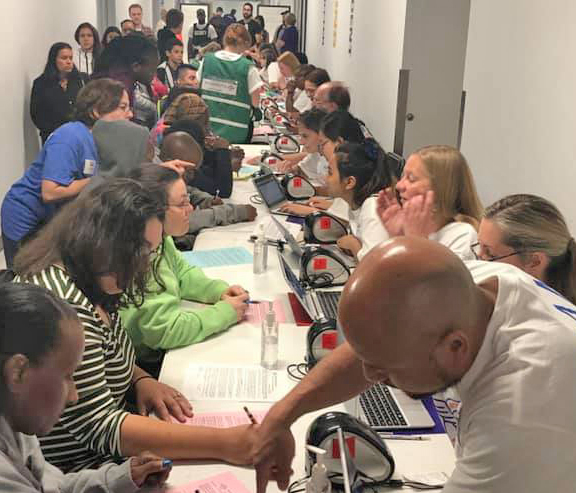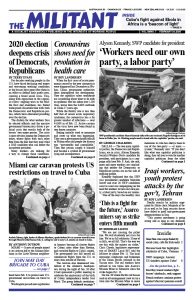For decades working people in the U.S. have faced declining real wages and worsening working conditions as the bosses have gone after them in an effort to defend their profit rates, creating a broad social crisis. This, along with opposition to the capitalist rulers’ ongoing wars in the Middle East and elsewhere, has fueled widespread dissatisfaction with both the Democratic and Republican parties, which have alternated presiding over the decline.
The disdain for what workers face by elected officials and the massive government bureaucracy drives a political crisis that wracks both of the bosses’ two major parties. The crisis is most obvious among the Democrats today, whose fights with each other flow from the fear that they won’t find a 2020 candidate who can defeat the incumbent president.
Many workers are looking for a way to change these conditions. Supporters of the Socialist Workers Party 2020 ticket for president and vice president, Alyson Kennedy and Malcolm Jarrett, find interest among workers in discussing an action program to defend ourselves from the employers and the government that serves them.
In contrast, the capitalist candidates — from President Donald Trump to Joe Biden, Pete Buttigieg and democratic socialist Bernie Sanders — offer different ways to defend, regulate and manage the capitalist system.

This broad discontent helped propel Trump to the presidency in 2016. He presented himself as an “outsider” who would end the carnage working people face and take on the “swamp” in Washington. Today Trump talks less about the carnage, laying claim to having reduced unemployment and creating “the Great American Comeback” as he runs for reelection.
His poll numbers are rising as he campaigns on a platform of “peace and prosperity,” especially after the utter failure of the Democrats’ impeachment crusade and the fiasco of their Iowa caucuses. He’s also making a pitch to win more support among African Americans. All this has deepened the Democrats’ trepidations and backbiting.
The upturn in employment has created better conditions for workers to begin organizing to fight attacks by the bosses, as more workers sense if they lose one job they’ll be able to find another. But the bosses aren’t giving up on their efforts to drive down wages as they face competition from rivals at home and abroad.
Democratic and Republican administrations alike have aided the bosses’ efforts to push the crisis of their system onto our backs, and workers continue to feel the impact despite the upturn. Increasing numbers of young people are unable to afford their own homes or start families. Millions face rising costs of basic necessities as well as skyrocketing debt. Insecurity about what the future will bring marks the lives of workers and farmers across the country.
These conditions — ones that brought Trump to the presidency — are also creating support for the nomination of Bernie Sanders.
Support for Sanders surged in Iowa and he edged out a victory in the New Hampshire primary, followed closely by centrist Buttigieg. And it’s becoming clearer that the Democratic Party machine — that believes a Sanders campaign would mean a rout for the party’s candidates in November — are out to rig the nomination for one of their own, like former New York Mayor Mike Bloomberg.
Joe Biden is rapidly tumbling as the front-runner, making a poor showing as the “beating-Trump-is-everything” candidate that other Democrats can unite behind. He came in fourth in Iowa.
War in the Democratic Party
“In any other country Joe Biden and I would not be in the same party,” Sanders supporter Rep. Alexandria Ocasio-Cortez said Jan. 7, highlighting the split among Democrats. Days later she assured party members that she was a “proud Democrat” but admitted she was withholding her dues to the party in protest at how it selects its candidates.
Sanders runs on a platform of radical reform, railing against the wealthy and proposing to patch up capitalism. He touts plans to hike taxes to fund an expansion of government-backed Medicare health insurance. He says he would raise the federal minimum wage to $15 an hour, and praised Amazon CEO Jeff Bezos two years ago when Bezos set Amazon’s minimum wage at that meager level.
He points workers away from relying on our own capacities to organize and struggle against the bosses and urges them to rely on him to “stand up to Wall Street,” and make things fairer. He encourages dependency on the state and its massive regulatory bureaucracy to do good things for working people if they’ll just put him in office. This is his plan, rather than a struggle by workers and our allies to replace the state with our own government — one that can lead millions to transform social relations and ourselves in the process.
His democratic socialist supporters at Jacobin magazine say he would emulate Franklin Delano Roosevelt, enacting a raft of executive orders from the White House to do good, because there’s no way he could pass legislation to do so.
They point to how Roosevelt used anti-democratic orders to create the Office of Scientific Research and Development, as well as the key bodies to advance the U.S. rulers’ entry into the second imperialist world war — like the War Labor Board that tried to impose a wage freeze on workers.
The Democrats have spent three years — since the day Trump was elected — trying to overturn the vote that put him in office so they wouldn’t have to face him again this November.
Attacks on workers’ rights
“We might have to impeach him again,” headlined a Washington Post column by George Conway Feb. 10, citing the president’s dismissal of Lt. Col. Alexander Vindman and Gordon Sondland, the U.S. ambassador to the European Union, from their jobs Feb. 7, as is his right as chief executive. Both testified against the president during House impeachment hearings.
In their drive to oust Trump and push out of politics the “deplorable” workers who refuse to vote the “right way,” the liberals target key political rights working people have won in struggle — like the right to vote at all.


